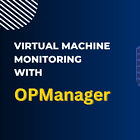To ensure uninterrupted information transmission, an organization’s IT operations require a trustworthy database & real-time Monitoring system. It is particularly true for business-critical applications, as database system interruptions immediately affect end users’ experiences and eventually hurt your income, reputation & brand.
Learning about database systems’ challenges and how their monitoring may assist in overcoming these issues should be one of the main KPIs within the IT department. Additionally, educate oneself on database monitoring best practices and how they may help your business save time and money.
Do You Know Why Data Base Performance Monitoring is Essential?
An administrator’s first step whenever an application fails, or experiences latency problems is to look for underlying issues in the database.
We must constantly monitor databases for health, availability, and perform maintenance in our fast-paced, impatient and challenging world. Unchecked database issues can cause excessive resource use, server and application failures, memory problems, and increased latency, which might be detrimental to you and your company.
Users may get errors such as “Your login credentials cannot be found” for instance, while attempting to connect to their online purchasing accounts. This occurs when the associated database system, where login credentials are kept for authentication, cannot be accessed by the website. Or a web application could occasionally take too long to query data from the necessary databases, resulting in performance lag.
These are all examples of database-related problems that could cause users to leave. Organizations may use database performance monitoring tools and resources to avoid such annoyances.
How should Database Performance be Monitored?
Database performance monitoring collects data by proactively gathering comprehensive metrics from a data storage system to learn more about its functionality and effectiveness in real-time. Doing so may spot database-related problems before they become significant problems and guarantee that your consumers enjoy using your online applications.
Because most businesses depend on a sizable IT infrastructure, it could be difficult for administrators to maintain a close eye on their database systems. That’s why we use a capable database monitoring solution to automate and streamline queries.
Monitoring Database Performance Requires an Understanding of These Metrics
We can use metrics like availability, DB response, indexing, capacity, sessions, and performance to gauge a database system’s health and determine how it will affect the performance of the connected application.
We can use these criteria to find any flaws that can directly or indirectly influence your database architecture. The following are the top five elements that might have an impact on a database system’s performance:
- Lengthy SQL queries
- Session/job overload
- Insufficient indexing
- Massive data types
- Insufficient capacity
A database monitoring and evaluation tool seek to continuously track vital performance indicators that might provide clues about an issue or aid in its prevention. Below are a few critical database performance metrics:
- Database response
- Database events
- Health and availability
- Performance and capacity
Database Response
Using inefficient developer-written code, which may result in duplication, an increase in exponential query time, and bloated indexes, is another crucial factor contributing to performance bottlenecks.
A SQL query should only process as much data as is necessary, and it is also inefficient to use numerous queries when one might do the task. These occurrences might result in postponed SQL queries, which would slow down background transaction performance for your application and lengthen database response times.
The database monitor in Applications Manager identifies time-consuming and costly query statements. Administrators can make the required adjustments to a query statement to make it more efficient using characteristics like CPU time and execution time.
Database Events
A thorough understanding of database events is required to identify discrepancies that might develop into serious problems. Using trends, a traditional monitoring tool may reveal database events as session information.
Using the Applications Manager’s database performance monitoring system, you may obtain the specific performance breakdown of the active sessions/jobs and the related components. Utilize metrics such as operational status, reaction time, memory utilization, user information, application information, database details, and more to make the required changes and adjustments to improve the data storage system.
Health & Availability
One of the most critical aspects of database monitoring is health and availability. The ability to ensure that data is always accessible can significantly impact an organization’s income stream.
Customers will be far more inclined to trust your application if you invest in a monitoring solution to ensure the database is always available.
Database monitoring tools like ManageEngine Applications Manager allow customers to establish an availability threshold that would automatically identify and warn administrators in an instance of unavailability or downtime, making things easier.
Performance and Capacity
Database performance issues are typically brought on by improper resource allocation. Database resource planning mistakes might result in performance bottlenecks, negatively affecting end-user satisfaction.
The main goal of utilizing a tool to track database performance is to provide administrators with some level of insight into the internal workings of a database system.
Administrators may locate and assign resources for a more effective database system using database monitoring tools like Applications Manager. We can use information from the Applications Manager’s DB monitoring tool, such as information on network traffic overload, I/O activities, CPU load, or memory use, to make changes to the database infrastructure.
Applications Manager’s Database Monitor
Applications Manager from ManageEngine is a one-stop shop for all of your database monitoring and performance analysis requirements. Because Applications Manager offers out-of-the-box monitoring for many technologies inside a single interface, it differs from existing database performance monitoring systems.
Using Applications Manager’s database monitoring services has several significant benefits, including:
- Comprehension of SQL query execution at the code level.
- Monitoring the replication feature.
- Widgets, business process groups, and personalized dashboards for effective database administration.
- Alarm and threshold profiles for the monitoring of critical properties.
- Data visualization for performance assessment.
- A simple agentless monitor configuration.
- A sophisticated capability that allows output for specific query statements to be monitored.
Along with supporting traditional databases, monitoring is also supported for NoSQL databases like MongoDB and Cassandra and cloud databases like Azure SQL Database.
With the right tools its not that hard to manage your daily database related quires and fixes. But if you still need a professional to assist your business needs you can book an appointment with our certified technicians to assist you.

